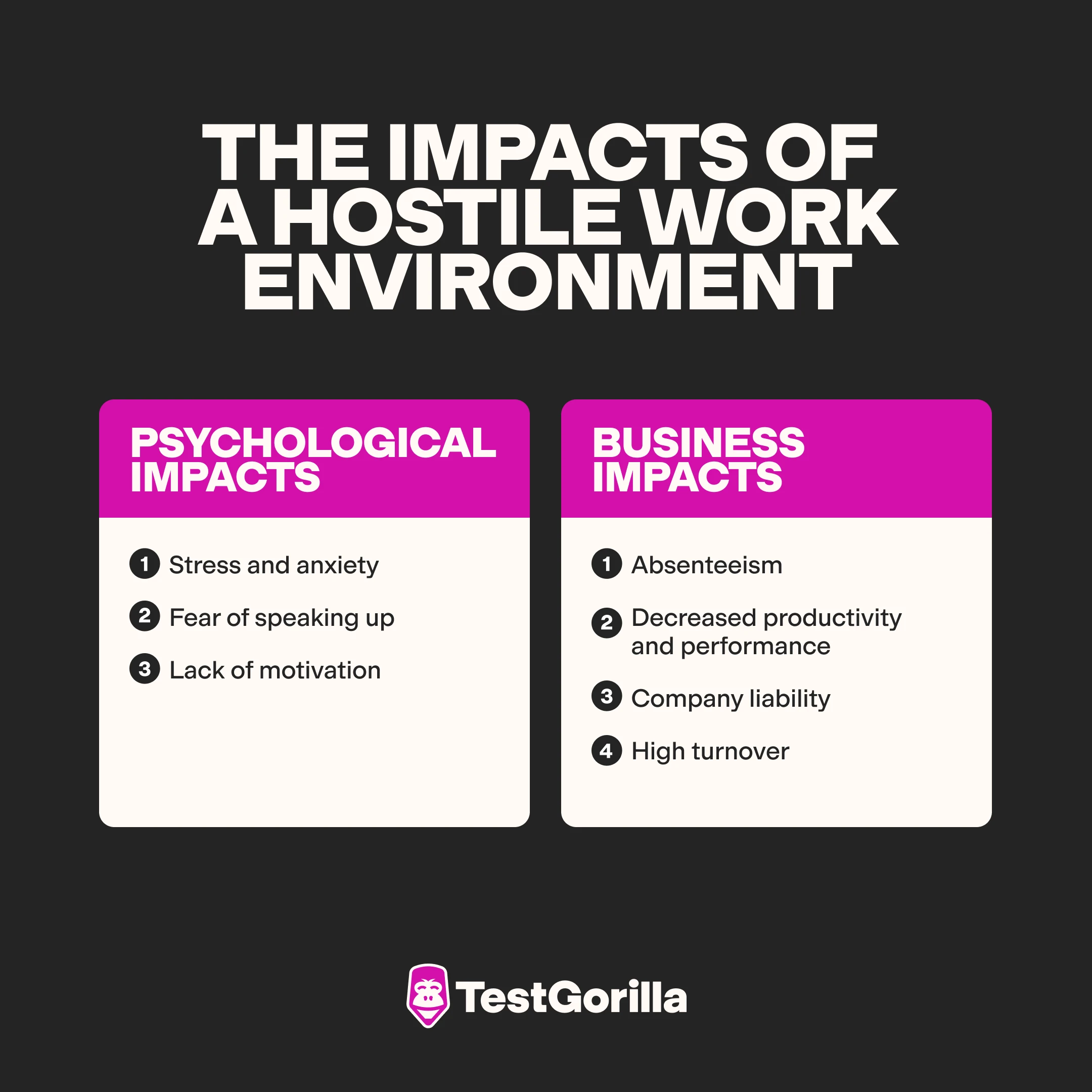What is a hostile work environment? Signs and solutions
If you’ve noticed tension, a drop in morale, or excessive conflict in your workplace, you’re not alone. A 2023 survey from the American Psychological Association revealed that 1 in 5 employees reported their workplace environment was somewhat to very toxic.
Perceptions of workplace hostility are common, but where do you draw the line between everyday work tension and a hostile work environment? And if your workplace does fit the criteria, what can you do about it?
If you’ve been pondering these questions, this article is for you. You’ll learn the legal criteria of a hostile work environment, the impacts of a hostile work environment on business performance, how to spot the telltale signs, and how to build a supportive company culture in place of a hostile one.
Table of contents
Key takeaways
A “hostile work environment” is a legal term with specific criteria, and hostility can be overt or covert.
The impacts of a hostile work environment can be devastating to individuals and business performance.
The causes of a hostile work environment range from poor hiring practices to career stagnation.
There are numerous ways to prevent a hostile environment and build a supportive one, including talent assessments that help you hire people who share your company values.
What is a hostile work environment?
Some friction or conflict at work is natural – we’ve all experienced it. When conflict pervades your team culture, it may go beyond everyday tension. But does it fit the legal definition of a hostile work environment? The Equal Employment Opportunity Commission (EEOC) has specific criteria for a workplace to be qualified as hostile. They are:
Discriminating against a protected identity category, such as race, sex, gender, religion, or disability.
Behaving or acting in a way that is so severe, a reasonable person would see it as hostile, intimidating, abusive, and harmful to work or career growth.
Demonstrating ongoing behavior or actions. An isolated incident – no matter how disruptive, inappropriate, or harmful – doesn’t meet the criteria.
Additionally, the employer must have been found to be aware of the actions but didn’t intervene.
According to the EEOC, hostile behavior can come from management, supervisors, employees, or even customers or clients.
But what constitutes a hostile action or behavior? Well, hostility can be either overt or covert. Let’s break these down with some examples to paint a picture.
Overt hostility
This kind of workplace hostility is usually easier to recognize as these behaviors fit most people’s understanding of hostility. Examples include:
Denigration or humiliation: This is when an individual’s contributions are openly or publicly mocked or ridiculed. Individuals may be targeted based on either personal qualities or identity categories.
Harassment: This may include sexual harassment (unwanted sexual touching, comments, or advances) or generalized harassment or bullying, including threats or intimidation.
Physical aggression: This can be anything from physical intimidation, the invasion of personal space, or aggressive gestures, such as knocking items over in anger, slamming fists on tables, etc. It doesn’t have to include physical contact.
Covert hostility
This type of hostility can be harder to detect but is often equally serious as overt hostility. Numerous successful lawsuits have been filed for covert forms of hostility in recent years, so it’s important to keep on the lookout for the following behaviors:
Microaggressions: These are subtle comments or actions that harm an individual. While often experienced by minorities and women, microaggressions can happen to anybody. This includes being frequently interrupted, insulted, subjected to “jokes,” or having efforts consistently downplayed.
Devaluing contributions: When an employee’s ideas are shot down or devalued without good reason, it can be demoralizing. This goes beyond healthy disagreement when the intent is to bully or exclude.
Unreasonable job demands: This happens when an employee is given too much work, tight deadlines, or impossible standards to meet.
Exclusion: This is when employees are regularly left out of work projects or social gatherings. This can lead to cliques forming and unfair distribution of opportunities and resources.
What isn’t a hostile work environment
Not everything perceived to be unpleasant makes for a hostile work environment. Here are some examples of what doesn’t count as one:
Constructive feedback: Provided respectfully and aimed at professional growth.
One-off events: No matter how unpleasant, a single event of workplace hostility does not qualify as a “hostile work environment.”
Fair disciplinary actions: Applied consistently and based on clear policies.
Reasonable work demands: Aligned with job descriptions and capacities.
Performance evaluations: Conducted objectively and based on set criteria.
Professional disagreements: Handled with respect and focused on resolving issues.
The impacts of a hostile work environment
As social creatures, our well-being is closely tied to our environment. A toxic workplace can have profound psychological impacts on employees that come with knock-on effects on business performance.
Psychological impacts
First, let's consider the human cost of a hostile work environment.
Stress and anxiety
When employees face bullying, unfair expectations, and other forms of workplace hostility, it can take a toll on their mental health. It can impede good decision-making and the ability to focus on critical goals.
Fear of speaking up
Valuable contributions are often lost if employees fear being mocked or devalued. Employees might not recognize their own insights if they’ve been conditioned to devalue them.
Lack of motivation
Being in a positive, supportive environment makes employees feel excited to work and contribute. A hostile work environment does the opposite. If employees are surrounded by hostility, they often experience lower energy and motivation levels.
Business impacts
Psychological impacts have a domino effect on your organization and translate to poor business outcomes. Impacts include:
Absenteeism
When employees are bullied, denigrated, or harassed, they won’t want to come to work all the time. US businesses lose an estimated $223 billion annually due to absenteeism linked to workplace harassment.
Decreased productivity and performance
Harassment and bullying at work may lead to increased performance anxiety and depression, which are both linked to poor performance. In fact, 60% of employees experiencing workplace harassment report decreased work performance as a result of the abuse.
Company liability
As we continue to see an increased awareness of harassment and power imbalances in the workplace, employees who’ve experienced it are suing in record numbers. The EEOC’s 2023 report found that $665 million was recovered for victims of workplace harassment – a 30% increase from the previous year.
High turnover
Today’s workers increasingly value their health over other measures. Gen-Z-ers, in particular, are less likely to put their mental health and well-being above their career. This means they’re much more likely than other generations to quit their jobs if they feel they’re in an unsafe work environment.
Research backs this up. An analysis from MIT Sloan found that toxic workplace culture was the top predictor of high employee turnover – with the most pronounced effects in the younger cohort.
6 causes of hostile work environments
A toxic workplace doesn’t form overnight – it has specific causes that build over time. Let’s look at six common causes below.
1. Lack of personality testing in the hiring process
Did you know that personality tests can predict how individuals may behave in the workplace, including their potential for negative interactions?
The Big 5 (OCEAN) test, also called the Five-Factor Model (FFM), is a well-known psychological framework that helps describe different aspects of personality. These five traits cover a range of behaviors and attitudes.
Research on the Big 5 shows that individuals who score low on Agreeableness (which comprises empathy, trust, altruism, and cooperation) may be more likely to engage in negative behaviors such as bullying – a main form of hostility.
By using personality assessments, companies can make more informed hiring decisions and help create a more positive work environment.
2. Underskilled employees
Sometimes, workplace friction happens when employees don’t have the right skills and other employees have to pick up the slack. This is a complex issue that could have many causes. In many cases, it comes down to making poor hiring decisions or not adequately testing for skills during the hiring process.
3. Leadership failures
Remember that individual hostile actions do not constitute a hostile environment. It occurs when leadership is aware of ongoing poor behavior but does nothing to address it. This inaction is what allows the negative culture to take hold.
In other words, leadership is always responsible for a hostile work environment.
4. Insufficient or outdated code of conduct guidelines
If there are no clear consequences for misbehavior, the worst in people often comes out. You need to have unambiguous guidelines for acceptable workplace behavior and easy reporting systems when transgressions are made.
You should also ensure your code of conduct guidelines cover more covert forms of hostility, such as microaggressions.
5. High-stress environment
On its own, stress doesn’t contribute to workplace hostility. If you have a strong team culture and the stress is shared among the team, it can even bring them together. However, when team culture is weak and communication is poor, stress can be the match that lights the fire, leading to hostile behavior.
6. Career stagnation
A 2023 study found a significant link between the negative emotions stemming from a “career plateau” and the anti-social, counterproductive behaviors that follow. When there are no growth opportunities on the horizon and employees feel they’re in a “dead-end” job, they can experience resentment and take it out on others.
7 ways to build a positive workplace culture
If you’re beginning to see signs of a hostile work environment brewing in your team, there are ways to turn the tide. Let’s look at some strategies below.
1. Use personality and culture tests
Talent assessments are an excellent way to build a positive team culture from the ground up. With evidence-based personality and culture tests, you can eliminate workplace hostility by hiring people who share your company values, such as empathy, trust, and adaptability. Here are some tests you can include as part of your recruitment process:
Communication skills test
Big 5 (OCEAN) test
Enneagram test
You can use these tests to go in-depth and be confident you’re hiring the right person. You can compare candidates instantly and identify people who will contribute to the culture you want to build.
⭐ Explore TestGorilla’s personality and culture tests to find the right ones for your business.
2. Take a skills-based hiring approach
Inadequately skilled employees often increase the workload of other employees, leading to frustration and tension. If you want to make sure your next hire has what it takes to succeed, include skill tests as part of your recruitment process. You can test for soft skills, including:
You can also test for role-specific skills, such as:
⭐ Check out TestGorilla’s library to see a range of tests you can use to screen candidates.
3. Train your leaders
Leadership needs to understand the costs of a hostile work environment, be active in building a positive work environment, and adopt a zero-tolerance policy toward bullying, harassment, and other forms of workplace hostility. Smart companies recognize this and invest in training that helps leaders do this. Training can come in the form of:
Workshops and seminars: Focused on effective communication, conflict resolution, and team-building exercises.
Leadership coaching: One-on-one sessions with experienced mentors to develop skills in managing and shaping team culture.
Diversity and inclusion training: Ensuring leaders are equipped to create an inclusive environment that values diverse perspectives.
4. Provide growth opportunities
Offering clear paths for career advancement can be a game-changer in building a positive workplace culture. When employees see opportunities for growth, they’re more engaged and motivated. It removes feelings of stagnation and fosters a sense of purpose and commitment. Try out these strategies:
Skill development programs: Offer training and workshops to help employees expand their skill sets.
Promotion pathways: Clearly outline the steps required for career advancement within the organization.
Mentorship programs: Pair employees with mentors who can guide their professional growth.
5. Encourage clear and open communication
When snide remarks, passive aggression, and other forms of hostility become the air your team breathes, aim to be a breath of fresh air – it might be contagious! Here are some ways to model clear and open communication:
Demonstrate active listening: Show genuine interest in what others are saying by listening attentively, asking clarifying questions, and not interrupting.
Use clear and concise language: Communicate your ideas and expectations in a straightforward manner, avoiding jargon or ambiguous statements.
Provide constructive feedback: Offer feedback that’s specific, actionable, and focused on improvement rather than criticism.
Encourage respectful discourse: Maintain a respectful and considerate tone, even during disagreements, to set the standard for professional communication.
In some cases, you need to be explicit. Make it clear what kind of communication you expect at work and what you will or won’t tolerate. If necessary, speak directly to regular offenders about their behavior and take appropriate action if violations are repeated.
6. Update your workplace code of conduct & ethics guidelines
Have you checked your code of conduct guidelines lately? They may be out of date. Over the past decade, an increased societal awareness of sexism, racism, and harassment has changed workplace expectations and dynamics. Your workplace code of conduct guidelines must take this shift into account. When updating your code of conduct, prioritize the following:
Disability and inclusion
Diversity policy
Constructive feedback
Respectful communication
Harassment and discrimination
Respect of personal space
The right to disconnect
Work-life balance
Each of these should include nuanced, up-to-date understandings of discrimination and harassment. If feasible, consult a legal expert to ensure compliance with local laws. Additionally, ensure it’s easy for employees to report violations. Leadership and HR must have an open-door policy when it comes to any form of workplace harassment, too.
7. Team-building exercises
Lastly, getting your team together to bond can help ease existing tensions and help build better relationships. Here are some ideas for team-building exercises:
Team workshops: Organize sessions focused on skills like communication, problem-solving, or leadership.
Icebreaker activities: Start meetings with short, engaging questions or games to help team members get to know each other.
Group challenges: Use activities like escape rooms or scavenger hunts to encourage teamwork and creativity.
Volunteer sessions: Participate in community service projects as a team to build camaraderie and give back.
Social events: Host casual get-togethers, such as lunches or happy hours, to strengthen personal connections.
Team retreats: Plan off-site retreats for focused team-building and relaxation away from the office.
Collaborative projects: Assign cross-functional projects to promote collaboration and understanding among team members.
Build a positive work culture from the ground up with TestGorilla
A hostile work environment can be devastating to employees and business performance. It comes in both overt and covert forms, which can be equally damaging. It saps motivation, increases litigation risk, and drives valuable talent out the door. It can be caused by everything from bad hires to failures in leadership.
Thankfully, by understanding the causes of a hostile work environment, you can begin taking steps toward building a supportive work environment that leads to business success. A great way to start is by using talent assessments with TestGorilla. Our test library contains a range of scientifically formulated personality, culture add, and skills tests that help you go beyond vague impressions and predict candidate fit with pinpoint accuracy.
Get started today for free, or register for a 45-minute demo and see how TestGorilla can help you make smarter hiring decisions.
FAQs
How can I identify early signs of a hostile work environment in my team?
Early signs of a hostile work environment include increased absenteeism, declining employee morale, and frequent complaints about interpersonal issues. Regularly check in with your team, encourage open communication, and take note of any patterns of behavior that may indicate underlying problems.
How can regular employee feedback help prevent a hostile work environment?
Regular employee feedback allows you to stay informed about the work environment and any issues that may be brewing. Conduct anonymous surveys or hold one-on-one meetings to gather insights, and act on the feedback to address concerns before they escalate. This proactive approach helps maintain a positive and respectful workplace.
Related posts
You've scrolled this far
Why not try TestGorilla for free, and see what happens when you put skills first.
Latest posts
The best advice on pre-employment testing, in your inbox.
No spam. Unsubscribe at any time.

Hire the best. No bias. No stress.
Our screening tests identify the best candidates and make your hiring decisions faster, easier, and bias-free.
Free resources
This checklist covers key features you should look for when choosing a skills testing platform
This resource will help you develop an onboarding checklist for new hires.
How to assess your candidates' attention to detail.
Learn how to get human resources certified through HRCI or SHRM.
Learn how you can improve the level of talent at your company.
Learn how CapitalT reduced hiring bias with online skills assessments.
Learn how to make the resume process more efficient and more effective.
Improve your hiring strategy with these 7 critical recruitment metrics.
Learn how Sukhi decreased time spent reviewing resumes by 83%!
Hire more efficiently with these hacks that 99% of recruiters aren't using.
Make a business case for diversity and inclusion initiatives with this data.



















